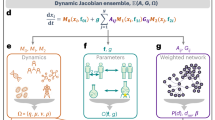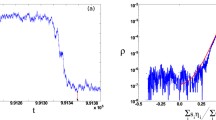Abstract
The fluctuation of dynamic variables in complex networks is known to depend on the dimension and the heterogeneity of the substrate networks. Previous studies, however, have reported inconsistent results for the scaling behavior of fluctuation in strongly heterogeneous networks. To understand the origin of this conflict, we study the dynamic fluctuation on scale-free networks with a common small degree exponent but different mean degrees and minimum degrees constructed by using the configuration model and the static model. It turns out that the global fluctuation of dynamic variables diverges algebraically and logarithmically with the system size when the minimum degree is one and two, respectively. Such different global fluctuations are traced back to different, linear and sub-linear, growth of local fluctuation at individual nodes with their degrees, implying a crucial role of degree-one nodes in controlling correlation between distinct hubs.
Similar content being viewed by others
References
D. J. Watts and S. H. Strogatz, Nature 393, 440 (1998).
R. Albert and A-L. Barabási, Rev. Mod. Phys. 74, 47 (2002).
A. Barrat, M. Barthélemy and A. Vespignani, Dynamical Processes on Complex Networks (Cambridge University Press, 2008).
A-L. Barabási and H. Stanley, Fractal Concepts in Surface Growth (Cambridge University Press, Cambridge, 1995).
D. Ben-Avraham and S. Havlin, Diffusion and reactions in fractals and disordered systems (Cambridge University Press, 2000).
S. Dorogovtsev, A. Goltsev and J. Mendes, Rev. Mod. Phys. 80, 1275 (2008).
E. Bullmore and O. Sporns, Nat. Rev. Neurosci. 10, 186 (2009).
G. Korniss, M. A. Novotny, H. Guclu, Z. Toroczkai and P. A. Rikvold, Science 299, 677 (2003).
R. Albert, I. Albert and G. L. Nakarado, Phys. Rev. E 69, 025103 (2004).
M. Rohden, A. Sorge, M. Timme and D. Witthaut, Phys. Rev. Lett. 109, 064101 (2012).
A. E. Motter, S. A. Myers, M. Anghel and T. Nishikawa, Nat. Phys. 9, 191 (2013).
J. Gao, B. Barzel and A-L. Barabási, Nature 530, 307 (2016).
F. Family, J. Phys. A:Math. Theor. 19, L441 (1986).
A-L. Barabási and R. Albert, Science 286, 509 (1999).
A. L. Pastore y Piontti, P. A. Macri and L. A. Braunstein, Phys. Rev. E 76, 046117 (2007).
C. E. La Rocca, L. A. Braunstein and P. A. Macri, Phys. Rev. E 77, 046120 (2008).
D. Torres, M. A. D. Muro, C. E. L. Rocca and L. A. Braunstein, EPL (Europhysics Letters) 110, 66001 (2015).
H-H. Yoo and D-S. Lee, Phys. Rev. E 93, 032319 (2016).
M. Molloy and B. Reed, Random Structures & Algorithms 6, 161 (1995).
M. Catanzaro, M. Bogu˜ná and R. Pastor-Satorras, Phys. Rev. E 71, 027103 (2005).
K-I. Goh, B. Kahng and D. Kim, Phys. Rev. Lett. 87, 278701 (2001).
A. N. Samukhin, S. N. Dorogovtsev and J. F. F. Mendes, Phys. Rev. E 77, 036115 (2008).
J. Park and M. E. J. Newman, Phys. Rev. E 68, 026112 (2003).
J-S. Lee, K-I. Goh, B. Kahng and D. Kim, Eur. Phys. J. B 49, 231 (2006).
D-S. Lee, K-I. Goh, B. Kahng and D. Kim, Nucl. Phys. B 696, 351 (2004).
S. F. Edwards and D. R. Wilkinson, Proc. R. Soc. Lond. A 381, 17 (1982).
S. Hwang, D-S. Lee and B. Kahng, Phys. Rev. E 90, 043303 (2014).
Author information
Authors and Affiliations
Corresponding author
Rights and permissions
About this article
Cite this article
Yoo, HH., Lee, DS. Relevance of the Minimum Degree to Dynamic Fluctuation in Strongly Heterogeneous Networks. J. Korean Phys. Soc. 72, 748–754 (2018). https://doi.org/10.3938/jkps.72.748
Received:
Published:
Issue Date:
DOI: https://doi.org/10.3938/jkps.72.748




